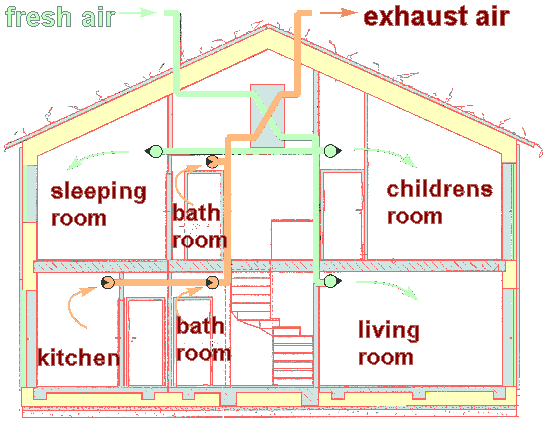| |
Why
a mechanical ventilation system is recommended - at least in Passive
Houses
|
|
|
The scheme of a comfortable ventilation system. Stale air (brown) is removed permanently from the rooms with the highest air pollution. Fresh air (green) is supplied to the living rooms. (Section from the Passive House estate at Hannover Kronsberg, design by Rasch & Grenz. These row houses have been opened during the field trip of the 10th Conference on Passive Houses, Sunday, May 21st 2006)
This is how a counterflow heat exchanger works: The warm air (red, extract air) flows through a channel and delivers heat to the plates. This air will leave the exchanger cooled (orange, then called exhaust air). On the opposite side of the exchanger plates the fresh air (blue) flows in separate channels. This air will absorb the heat and it will leave the exchanger with a higher temperature (but still unpolluted), then called supply air (green). The counterflow principle allows for almost 100% recovery of the temperature difference, if the exchanger is long enough. In practise, systems with 75% to 95% are available. |
|
The
health and comfort of the inhabitants are the most important objectives
of a Passive House design. Excellent indoor air quality is indispensable.
But this can only be achieved if stale air is exchanged with fresh
outdoor air at regular intervals. This can definitely not be done
by just opening windows twice a day. Find
more information about ventilation in a Passive House.
Compact
systems - the integration of the complete building services
in the ventilation system. This is possible in Passive Houses. (updated:
2006-09-23 thanks
to Dylan Lamar for proof reading of the 1st edition |

